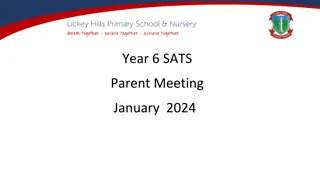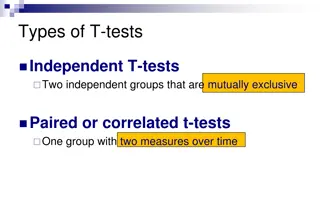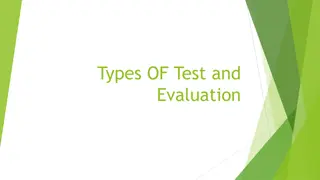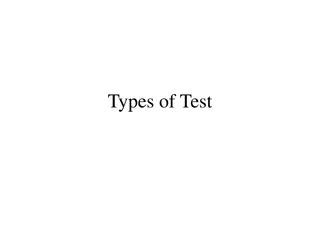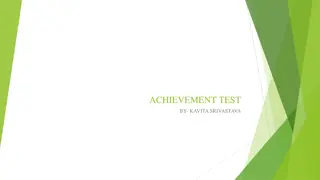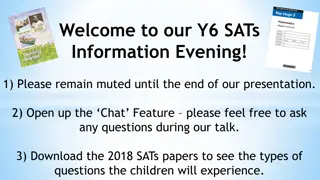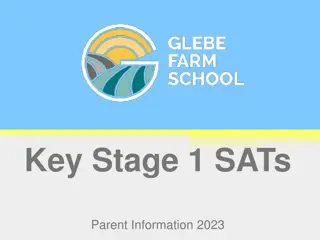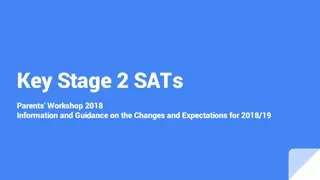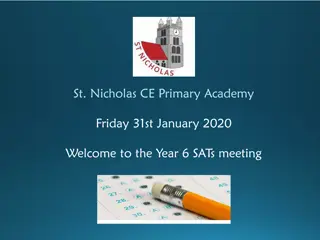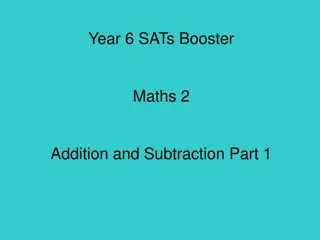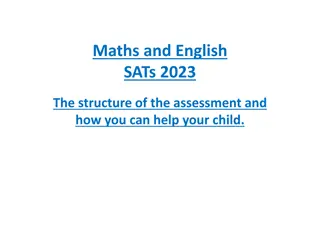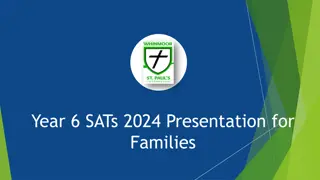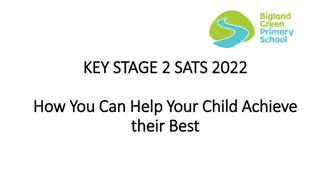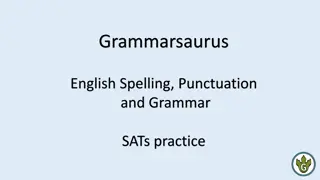Understanding Year 6 SATs: Tests, Procedures, and Results
Year 6 SATs are compulsory assessment tests conducted in May for students in Year 6 to evaluate their skills in Mathematics, Reading, SPAG, Science, and Writing. These tests are externally marked, with results reported in raw scores, scaled scores, and judgments against the national standard. Test durations vary for different subjects, with a significant emphasis on grammar, punctuation, spelling, and overall academic performance. Parents are encouraged to support their children to make a difference in their learning journey.
Download Presentation

Please find below an Image/Link to download the presentation.
The content on the website is provided AS IS for your information and personal use only. It may not be sold, licensed, or shared on other websites without obtaining consent from the author. Download presentation by click this link. If you encounter any issues during the download, it is possible that the publisher has removed the file from their server.
E N D
Presentation Transcript
Rylands Junior School Year 6 SATs meeting Aims of the meeting: to inform you about Year 6 SATs to encourage you to support your child and make a significant difference to their learning
What are SATs? Compulsory Statutory Assessment Tests (SATs) tests are carried out every year in school with children in Year 2 and Year 6. These tests are set by the Department for Education and must be taken in a particular week in May. All maintained schools in the country take the same test on the same day. The tests take place w/b 9thMay 2022 and last until Thursday 12thMay 2022. The Mathematics, Reading and SPAG ( Spelling, Punctuation & Grammar) test are marked externally As Science & Writing are teacher assessed these subjects continue until the end of June GOOD NEWS : No Science sampling testing will take place this year There is a national standard -the raw score achieved will link to a scaled score .Michael Tidd: https://www.youtube.com/watch?v=2H2D1Ul4pjE
How are the SATs carried out? The tests will take place during normal school hours, under exam conditions; Children are not allowed to talk to each other from the moment the assessments are handed out until they are collected after the test has ended; Afterwards, the completed papers are sent away to be marked externally; The children s results are sent back to school early July; The standard timings of tests differ but last no more than 60 minutes: - Grammar, Punctuation and Spelling (Paper 1) 45 minutes; - Grammar, Punctuation and Spelling (Paper 2) 15 minutes; - Reading 60 minutes; - Maths Paper 1 (Arithmetic) 30 minutes; - Maths Paper 2 (Reasoning) 40 minutes; - Maths Paper 3 (Reasoning) 40 minutes.
What sort of results are reported? Once marked, the tests will be given the following scores: o A raw score (the total number of marks achieved for each paper); o A scaled score (which is explained below); o A judgement of whether the National Standard has been met. After marking each test, the external markers will convert each raw score into a scaled score to show whether each child is working below, at or above the national standard. When the scaled score is given, it is given in a range from 80 to 120. A scaled score of 100 or more is meeting the national standard. There are no separate tests for higher achieving pupils; however, a scaled score above 110 would show that a child is working above the national standard.
Grammar, punctuation and Spelling 2 papers 1 x short answers 45 minutes to complete and worth 50 marks 1 x spelling paper 20 questions Spelling is just as important as grammar and the designated paper is worth 20 marks Greater focus on knowing and applying grammatical terminology with the full range of punctuation tested. Technical terms in grammar tested. Spelling patterns and methodologies form the basis of spellings tested.
Grammar, punctuation and Spelling Grammar, Punctuation and Spelling (Paper 1) is the longer paper lasting 45 minutes, which takes place on Monday 9thMay 2022. The children will be prepared so they are equipped with a good knowledge of the technical vocabulary needed to identify and describe various aspects of grammar and punctuation marks. Grammar, Punctuation and Spelling (Paper 1) focuses on the following areas: - Grammatical terms/word classes; - Functions of sentences; - Combining words, phrases and clauses; - Verb forms, tenses and consistency; - Punctuation; - Vocabulary; - Standard English and formality. Grammar, Punctuation and Spelling (Paper 1) requires a range of answer types such as circling missing capital letters, multiple choice questions, one-word answers, but does not require longer formal answers.
Grammar, punctuation and Spelling Example questions:
Grammar, punctuation and Spelling Example questions:
Reading Test 1 paper The Year 6 Reading SATs paper will be sat on Tuesday 10th May 2022. The assessment has been designed to measure whether children s comprehension of age-appropriate reading material meets the national standard. Texts in the English reading booklet will not be linked by a theme and there is now a greater focus on fictional texts and understanding of vocabulary. It has a standard timing of 60 minutes, including reading the texts and answering questions. There are three different set texts for the children to read, which could be any combination of non-fiction, fiction and/or poetry. The least demanding text comes first and the following texts increase in terms of difficulty. Children will have one hour to both read the texts and complete the questions. No reading support can be given during this test.
Reading Test 1 paper The Reading paper focuses on the following areas known as Content Domains: 2a) give/explain the meaning of words in context; 2b) retrieve and record information/identify key details from fiction and non-fiction; 2c) summarise main ideas from more than one paragraph; 2d) make inferences from the text/explain and justify inferences with evidence from the text; 2e) predict what might happen from details stated and implied; 2f) identify/explain how information/content is related and contributes to meaning as a whole; 2g) identify/explain how meaning is enhanced through choice of words and phrases; 2h) make comparisons within the text. The Year 6 Reading SATs paper requires a range of answering styles, including responding to multiple choice questions, one-word answers, and multiple mark questions which require more formal paragraph-length answers. .
Reading Test 1 paper Example question, based on Text 2 Giants: 2b) retrieve and record information/identify key details from fiction and non-fiction
Reading Test 1 paper Example question, based on Text 3 The Lost World : 2e) predict what might happen from details stated and implied
Reading Test 1 paper Since the current testing format for the Year 6 SATs began in 2016, there has been a tendency for the number of marks to go in favour towards three particular types of content domain / questions. For example: - 20% of marks could be gained by answering questions where children had to give/explain the meaning of words in context (Content Domain 2a); - Over a quarter of marks could be gained by answering questions where children had to retrieve/record information or details from the texts (2b); - Almost half of the marks were allotted to questions requiring children to make inferences from a text, justifying inferences with text evidence (2d). : So, when reading with your child at home, try asking questions like: Find a word in this paragraph that is closest in meaning to provide word e.g. annoyed (2a); In what year did provide fact e.g. the French authorities make it illegal for people to swim from France to England ? (2b); In the last paragraph, X does not want to Y. Give two reasons why X does not want Y. (2d)
Mathematics- 3 papers Arithmetic test to assess basic mathematical calculations where there are no contextualised questions. 36 questions, 40 marks available, 30 minutes duration. Questions will cover: straightforward addition and subtraction more complex calculations with fractions long divisions and long multiplications. Papers 2 and 3 are calculation papers ranging from 1 to 3 marks per question. Both of these papers are worth 35 marks each giving a total of 110 marks available.
Mathematics- 1 Arithmetic Maths Paper 1 (Arithmetic) will take place on Wednesday 11th May 2022. It has a standard timing of 30 minutes and is worth a total of 40 marks. It covers the four operations (division, multiplication, addition, subtraction and mixed operation calculations requiring BODMAS), as well as number properties, calculating percentages of amounts, calculations using decimals, and calculations using fractions.
Mathematics 2 & 3 Reasoning Maths Paper 2 (Reasoning) will take place on Wednesday 11th May 2022. Maths Paper 3 (Reasoning) is scheduled for Thursday 12th May 2022. Both have standard timings of 40 minutes and are worth 35 marks each. Paper 2 requires children to demonstrate their mathematical knowledge and skills, as well as their ability to solve problems and their mathematical reasoning. Questions focus on the following Mathematical topic areas: - Number and place value including Roman Numerals; - Addition, subtraction, multiplication and division (calculations); - Geometry properties of shapes; - Geometry position and direction; - Statistics; - Measurement including length, perimeter, mass (weight), volume, time and money; - Algebra; - Ratio and proportion; - Fractions, decimals and percentages. The questions get harder throughout the paper. It is not unusual for a child to be unable to complete the entire paper in time.
Mathematics 2 & 3 Reasoning
Mathematics 2 & 3 Reasoning
Scaled scores 2019 SCALED SCORES: A scaled score of 100- 109 means a child is working at age related expectations A scaled score of 110 or more means they are working above the expected standard A score below 100 means they are working below the expected standard . The thresholds tend to change each year according to overall national performance, so what was classed as did meet the expected standard in 2019 may have been considered a did not in 2018. 2019 Reading 28+/50 =ARE 2019 Mathematics 58+/110 =ARE 95+/110 = Higher standard 2019 ESP&G 36+/70= ARE 55+/70 = Higher Standard 41+/50= Higher Standard
Preparing for the tests in school We are giving children opportunities to: work independently see the layout and design of the tests complete work in a given time learn test strategies i.e. what to do if they cannot answer a question or read a word.
Ways to help at home: Remember ALL this should be fun. Ensure your child knows their times table and division facts and then extend this to 30 x 6, 420 7, Improve their mental addition or subtraction skills by asking them questions on the way to school e.g. 67+ 43. Test them on their spellings at home or on the way to school. Encourage them to complete tasks at home ie Mathletics activities/ revision booklets and activities -reading regularly if they need to become a more fluent reader -asking them questions about what they have read to improve their inference/deduction skills. They may be the best in the world at decoding, but they need to understand what they have read. Improve their reading skills by:
Encourage them to do their best. Firstly, a positive attitude goes a long way so as much encouragement and support as possible (but we don t need to tell you that!) Direct any questions or concerns you have about SATs to your child s teacher, rather than worry your child with them; Give your child opportunities to go outside and avoid overuse of screens - this can apply to leisure pursuits as well as how they study; Try to provide a quiet corner of the house for homework and study that s as free from distractions as possible; Encourage your child to talk to their teacher or another adult they trust if they express persisting anxieties about SATs. Remember that a small amount of anxiety is normal and not harmful; If your child is unwilling to talk to their teacher, talk to them yourself; Plan something nice and fun for the weekends before and after SATs this will help your child start the week well and also give them something to look forward to; Ensure your child is eating and drinking well, and getting a suitable amount of sleep.
Remember: SATs focus on what they know about Maths and English They won t reflect how talented they are at Science, Geography, Art or PE, and they certainly won t highlight positive personal characteristics such as kindness and integrity. SATs results don t always tell the whole story The results will say they DID or DIDN T meet a certain standard, but not necessarily by what margin. Additionally, the thresholds tend to change each year according to overall national performance, so what was classed as did meet the expected standard in 2019 may have been considered a did not in 2018. SATs last for one week In reality it s just one or two papers lasting 30-60 minutes each day. You can t emphasise enough the importance of keeping that in perspective.



